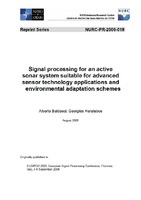| dc.contributor.author | Baldacci, Alberto | |
| dc.contributor.author | Haralabus, Georgios | |
| dc.date.accessioned | 2018-10-11T14:09:28Z | |
| dc.date.available | 2018-10-11T14:09:28Z | |
| dc.date.issued | 2006/08 | |
| dc.identifier | 24997 | |
| dc.identifier.govdoc | NURC-PR-2006-019 | |
| dc.identifier.uri | http://hdl.handle.net/20.500.12489/608 | |
| dc.description.abstract | An overview of the basic elements of an active sonar system in conjunction with a description of the signal processing chain utilized at the NATO Undersea Research Centre for detection and localization of undersea targets is presented. As | |
| dc.description.abstract | the focus of the Navy has shifted to the complex and volatile littoral environments characterized by high background interference, emphasis is given to the capability of advanced | |
| dc.description.abstract | sensor technology to resolve left/right ambiguity in the direction | |
| dc.description.abstract | of arrival and in broadband adaptation methods to enhance detection performance by incorporating in situ environmental | |
| dc.description.abstract | information in the processing chain. This processing was used in a series of sea trials organized and executed | |
| dc.description.abstract | by the Centre, a few of which included submarine targets. | |
| dc.format | 8 p. : ill. : digital, PDF file | |
| dc.language | English | |
| dc.publisher | NURC | |
| dc.source | In: EUSIPCO 2006, European Signal Processing Conference, Florence, | |
| dc.source | Italy, 4-8 September 2006 | |
| dc.subject | Signal processing | |
| dc.subject | Low Frequency Active Sonar (LFAS) | |
| dc.title | Signal processing for an active sonar system suitable for advanced sensor technology applications and environmental adaptation schemes | |
| dc.type | Reprint (PR) | |
| dc.type | Papers and Articles | |
